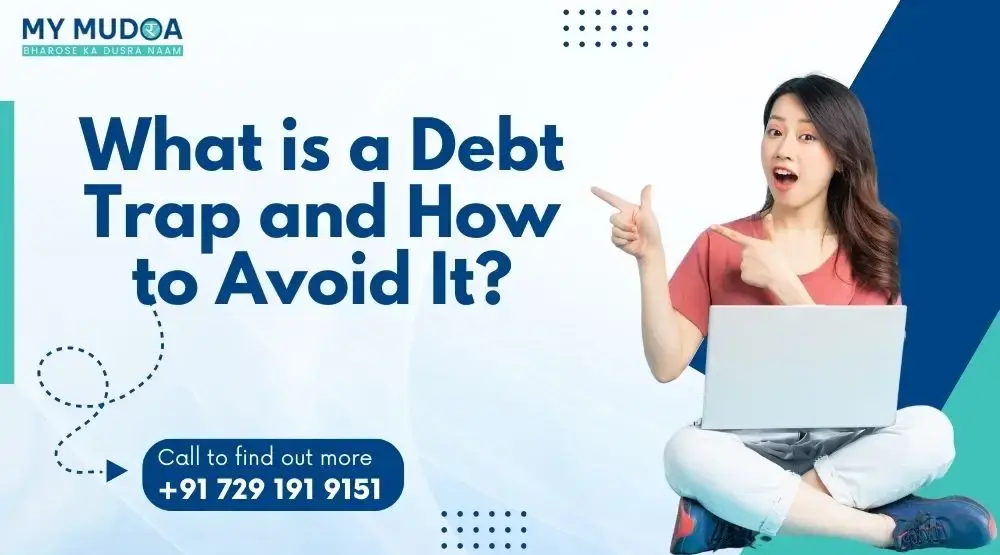
"A debt trap happens when you keep borrowing to repay old loans. Avoid it by spending smartly, paying on time, and not taking more loans than you need."

Published: 30 December 2024
Updated: 6 September 2025
Digital finance has made the process of financial inclusion convenient, but it also makes one raise a very valid question: Are we actually falling into personal debt traps without knowing? All due to the convenience of quick loans, credit cards, and buy-now-pay-later offers, people are borrowing beyond their means, believing these are temporary solutions. However, this debt cycle to pay older loans can soon get out of hand. The debt trap is a dangerous pit wherein financial freedom slips further and further away with each loan. As we adopt digital finance, it is necessary to ask: Are we making smart borrowing decisions, or are we digging ourselves deeper into debt?
A debt trap is when a person or a family gets stuck in a cycle of borrowing to pay off the existing debts and can't get out of it. It eventually becomes unsustainable and leads to increasing financial pressure, interest, and eventually failure to pay off their financial obligations. The debt trap is such that the borrower is caught in a loop, constantly needing new loans to cover old ones, making it nearly impossible to break free.
For example, Ramesh took a instant personal loan to pay for his family vacation. He could not pay the entire amount once the loan became due. In an attempt to fill this gap, he took another loan. This created a cycle where every new loan was becoming harder to repay the previous ones. Soon, Ramesh got himself into a debt trap. His monthly repayments were exceeding his income, and he had also lost all that hard-earned credit rating.
There are many causes of debt trap, but most commonly begin with some of the mistakes given below. When these primary sources of error are realized, then the chances of falling into debt traps decrease:
The best way to stop things from getting worse is knowing when you are caught in a cycle of debt trap early. Here are the common signs of a debt trap:
If you know your piling up debts, it is the time to do something in order not to be captured by debts. Here are some debt repayment tips for you:
Instant debt consolidation loans is one of the best solutions to a debt trap. Debt consolidation occurs when all your debts are combined into one loan with a lower interest rate and an easier repayment schedule. It will make it easier to pay off your debts in less time and will remove the burden of multiple monthly payments.
The Reserve Bank of India, has a consolidated debt consolidation guideline that should act as a safeguard for the consumers. The RBI suggests that banks and institutions giving finance should provide clarity through lending, competitive interest charges, and no charges/fees without consent by the consumer. The RBI further adds that debt consolidation loans should not carry penalties on early redemption and adequate time must be provided to the borrowers for the repayment of consolidated debt.
Freedom from a financial burden is hard to achieve but completely doable with discipline, strategy, and proper support. Here are debt management strategies that can help you take back control:
It can be a very overwhelming and daunting experience, but the right tools, knowledge, and support will help break free from this cycle. Whether it is through debt consolidation loan to avoid the debt trap, creating a realistic budget, or seeking professional advice, there are numerous ways to escape the cycle of borrowing and regain financial stability. Remember, the first step is recognizing the problem and taking proactive steps to overcome it. If you are caught in a credit card debt trap or a loan debt trap, then don't hesitate; seek help from debt counseling services or consider debt consolidation as a viable option.
Understanding what a debt trap is, its causes, and how to avoid it will take you through the control of your financial future and break the cycle of debt.
Also Read:
- What is Debt Consolidation: How Does It Work?
- What is Debt-to-Equity Ratio and How to Calculate it?
💬 Comments
Leave a comment or ask a question!
Please Enter Your Name
Please Enter Your Email
Please Enter Your Phone
Please Write Your Comment